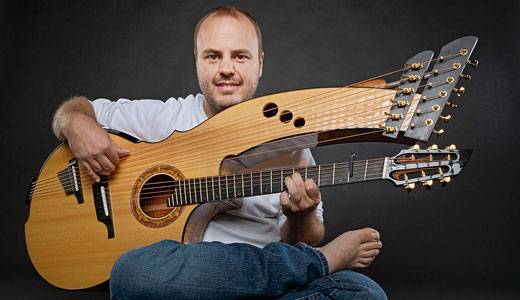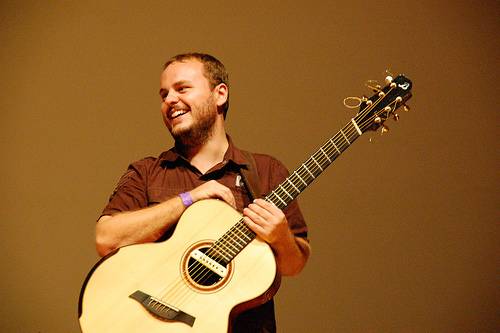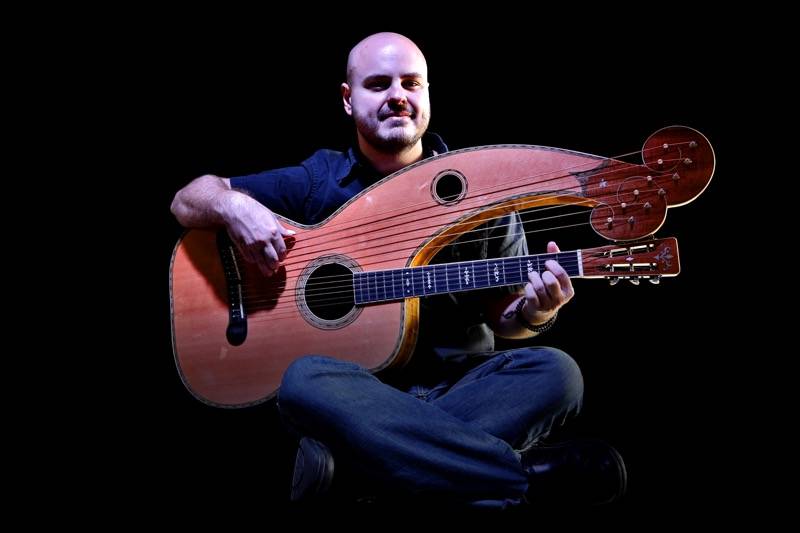Instrumental acoustic guitarist Andy McKee is incredibly gifted at what he does. His style of playing is fresh, innovative, and demanding of attention. When McKee was first cutting his teeth as a musician in the early 2000s, home Internet access was still new. Artists didn’t rely on it for publicity because they didn’t know what was possible. The qualities McKee possesses are pretty much required of musicians today, so it is not suprising to find that he had a leg up. In 2007, McKee found himself at the center of an infantile YouTube, acquiring his fame when the video-streaming website was still spanking new. There, McKee fell into being a pioneer of the concept of “going viral.” The video for his song “Drifting,” after creating a buzz on the website Digg, completely blew up on YouTube, even becoming the top streamed video for a while.
McKee was able to take the internet by storm because his guitar work is altogether unique. His fully engaged, double-handed technique, coupled with distinct guitar percussion, is something you’ve got to see to fully grasp.
The original video for “Drifting.”
It’s almost hard to tell if it’s the circa-2007 video quality that gives it the blurriness, or if it’s the pace of his playing.
McKee is tech-savvy, to say the least, and deft at this method of publicity. In addition to his amassing a large amount of fans through his music videos, he has also developed a following of pupils. McKee has several guitar tutorials on YouTube that have racked up enough views to rival that of “Drifting.” Watching that video was enough to inspire thousands of people.
Add that to his mastery of the somewhat exotic “harpguitar,” Andy McKee can be truly enthralling to watch.
I was able to speak with McKee about how the Internet impacted and changed his career and his hobby.

Smile Politely: When and why did you first decide to move beyond the techniques of traditional guitar-playing?
Andy McKee: When I was sixteen, I really got turned on to the acoustic guitar. I was listening to guys like Preston Reed and Michael Hedges and they really inspired me to try new things like altered tunings and using the guitar body as a percussion instrument. It was like the whole world of the guitar was opened up!
SP: The harpguitar is an instrument that is unfamiliar to many people. Can you tell me about how it sounds and plays as opposed to regular guitars?
McKee: The harpguitar has been around for hundreds of years in various shapes and numbers of strings. The one I play has six additional sub-bass strings situated above the regular guitar neck. When you hear one being played, it often sounds like a bass guitar and standard guitar at once. There are a couple of ways to approach playing the harpguitar; the first involves reaching up to play the harp strings with your right hand thumb while using your right hand fingers to play the guitar side. The other involves separating your hands so that the right hand plays the harp side and your left hand plays the guitar neck by utilizing hammer-ons and pull offs. Each approach has a different attack on the strings and can produce some very unique music.
SP: You achieved your initial popularity in early 2007 when the video for your song “Drifting” exploded on the then-recently-founded YouTube. What was it like to “go viral” before it was a term? How do you think it would be different nowadays?
McKee: Well I must say that it was completely unexpected. When the videos were uploaded we were hoping to get the attention of fans of instrumental acoustic guitar music, a niche genre for sure. But when it started to pick up and people were sharing the video of “Drifting” around, we were just stunned at the response. I didn’t know what to expect at the time. I was a guitar instructor at a local music store and I couldn’t have guessed that I would be getting offers to start performing all over the world. It truly changed the course of my life in a big way.
But as you mentioned, that was in the early days of YouTube and I do feel lucky that I had those videos up in the formative years of the site. I think it would be much more difficult to replicate that sort of success today. At least as an instrumental guitarist. There are just so many videos out there now that it seems like it would be hard to get noticed. But, I guess if something’s good there is always a chance it could go viral!
SP: Has it been easy to financially benefit from YouTube? Is your exposure to the audience that way different than it would be through just a CD release?
McKee: In an indirect way, yes I have benefitted financially from the viral videos. It has lead to me performing concerts over the last ten years which has enabled me to provide for my wife and kids, you know. But the videos themselves were actually uploaded by my former label and they keep any sort of advertising revenue that is generated.
I think the great thing about having used YouTube to expose people to my music is that some of my tunes have an interesting visual component to them. Like playing the harpguitar or playing over the top of the guitar neck in an unusual way. An audio CD just can’t capture that element.
SP: You’re known for your online guitar tutorial videos. Is your method of teaching guitar similar to the way you were taught?
McKee: Yeah I suppose so. I had about a year of private guitar lessons on electric guitar when I started, but I did learn a fair amount from VHS cassettes and transcriptions. When I teach, like at my music camp Musicarium for example, I try to slow things down and take each beat one-by-one so that the students can see exactly what is being done at any moment.
SP: How much real-life guitar tutoring do you do? What are the pros and cons between the two methods?
McKee: I don’t do much at all now other than at my music camp. Both methods are pretty identical for me, but teaching in person allows some interaction with the student and they can ask questions about the material. I love helping people learn on the guitar. I think it can be a great source of therapy.
SP: The accomplished acoustic guitarist Tommy Emmanuel recently played here in Champaign. You’re a fan and a friend. How has he influenced your musicianship?
McKee: Tommy is great. We kind of come from different ends of the acoustic guitar spectrum in a lot of ways; I come from a branch that’s a bit more inspired by Michael Hedges and he comes from one a bit more inspired by Chet Atkins you could say. But I can tell you that seeing him perform is always inspiring. He makes it look too easy!
SP: In addition to Emmanuel, who are some other musicians that have influenced your style?
McKee: My big four acoustic guitarist influences are Michael Hedges, Preston Reed, Don Ross, and Billy McLaughlin. Michael for his compositional sense, Preston for his percussive approach, Don for his sense of groove, and Billy for his melodicism. But overall, their music just really spoke to me in profound ways. I also love Eric Johnson on electric guitar. Bjork is a favorite, and also the Crash Test Dummies.
SP: Your recently released album, Live Book, shows how much of a good time you have when playing for an audience. How does your playing style differ between recording a tutorial and playing a live show?
McKee: Oh yeah, those are two very different things. A tutorial has to be very concise; you have to play through sections slowly, explaining each note and phrase in simple terms several times. When I play live, it’s like a meditation and I try to let the music come alive with different accents, dynamics, and pushes and pulls on the rhythm. When you are performing you have to really invest yourself into the music. That’s when it becomes art.

Andy McKee is playing an early show at The Accord on Friday, June 17th, with doors opening at 5 p.m. and the show starting at 5:30 p.m. Tickets are $20 advance/$25 at the door.








